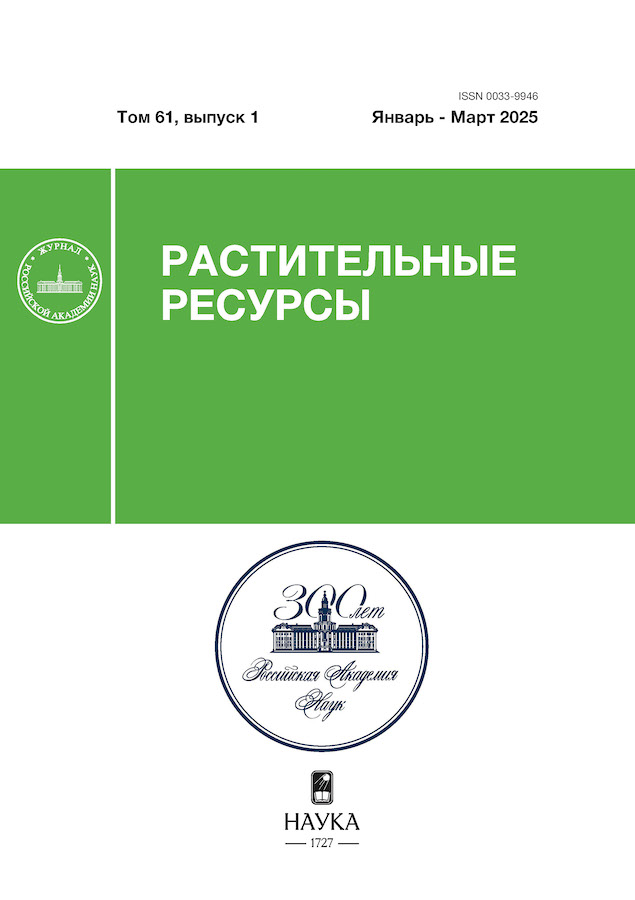Seed reproduction of Anemonoides altaica (Ranunculaceae) in the forest-steppe of West Siberia
- 作者: Gusar А.S.1
-
隶属关系:
- Central Siberian Botanical Garden SB RAS
- 期: 卷 61, 编号 1 (2025)
- 页面: 66-73
- 栏目: Biology of Resource Species
- URL: https://transsyst.ru/0033-9946/article/view/683235
- DOI: https://doi.org/10.31857/S0033994625010057
- EDN: https://elibrary.ru/EGQTOM
- ID: 683235
如何引用文章
详细
The article reports the seasonal development, seed productivity and the state of embryos in the seeds of Anemonoides altaica (C. A. Mey.) Holub. The studies were conducted for three years (2021–2023). In forest-steppe of West Siberia A. altaica successfully goes through all phenological phases. One generative shoot forms 31–37 seeds. The seed set coefficient (ratio of the number of seeds to the number of ovules) is very high (80.9–89.8%), realization of the seed yield potential is close to the maximum value. During seed dispersal, the embryos in the seeds are not differentiated and go through the initial stages of development: globular and triangular. The majority of seeds are well filled and contain embryos and endosperms. The proportion of defective seeds (with disturbance in embryo or endosperm development) is insignificant (reaching 3%). Based on the following reproductive indicators: seasonal development, seed productivity and development of embryos in seeds, A. altaica is considered as a promising species for cultivation in the forest-steppes of Western Siberia.
全文:
作者简介
А. Gusar
Central Siberian Botanical Garden SB RAS
编辑信件的主要联系方式.
Email: gusara663@gmail.com
俄罗斯联邦, Novosibirsk
参考
- Timokhina S. A. 1993. Anemonoides Miller. — In: [Flora of Siberia]. Novosibirsk. Vol. 6. P. 145–149. (In Russian)
- Krasnopevtseva V. M. 2007. [Ecological and biological features of spring ephemeroids – relict plant species of the Khamar-Daban Range (southern Baikal region): Abstr. … Dis. Cand. (Biology) Sci.]. Ulan-Ude. 24 p. (In Russian)
- Anemonoides Mill. — In: [Plant Resources of Russia: Wild flowering plants and their component composition and biological activity. Family Magnoliaceae–Juglandaceae, Ulmaceae, Moraceae, Cannabaceae, Urticaceae]. 2008. Vol. 1. St. Petersburg; Mosсow. P. 33-34. (In Russian)
- Vereshchagin V. I., Sobolevskaya K. A., Yakubova A. I. 1959. [Useful plants of Western Siberia]. Leningrad; Moscow. 347 p. (In Russian)
- Minaeva V. G. 1991. [Medicinal plants of Siberia]. Novosibirsk. 428 p. (In Russian)
- [Rare and endangered plants of Siberia]. 1980. Novosibirsk. 224 p. (In Russian)
- Semenova G. P. 2007. [Rare and endangered species of Siberian flora: biology and protection]. Novosibirsk. 408 p. (In Russian)
- Paromov V. V., Zemtsov V. A., Kopysov S. G. 2017. Climate of West Siberia during the slowing phase of warming (1986–2015) and prediction of hydro-climatic resources for 2021–2030. — Bulletin of the Tomsk Polytechnic University. Geo Assets Engineering. 328(1): 62–74. https://elibrary.ru/ygsrwh (In Russian)
- Yamskikh I. E., Chizhikova M. I. 2011. The state of Anemonoides altaica C. A. Mey. coenopopulations in the southern Krasnoyarsk region. — Russ. J. Ecol. 42(4): 333–338. https://doi.org/10.1134/S1067413611040205
- Beydeman I. N. 1974. [Methods for studying plant phenology and plant communities]. Novosibirsk. 156 p. (In Russian)
- Vaynagy I. V. 1974. On the method of studying the seed productivity of plants. — Botanicheskii Zhurnal. 59(6): 826–831. (In Russian)
- [Guidelines for seed studies of introduced species]. 1980. Moscow. 63 p. (In Russian)
- Shamrov I. I. 2006. Embryogeny. — In: Embryology of flowering plants. Terminology and concepts. Viol. 2: Seed. Enfield; Plymouth. P. 175–186.
- Maslennikov A. V., Maslennikova L. A., Faskhutdinova L. F. 2012. [Cenopopulation studies of Anemonoidеs altaica (Fisch. ex С. A. Mey.) Holub. near the Undory village]. — In: [Nature of the Simbirsk Volga region: scientific works of the XIV interregional scientific and practical conference]. Ulyanovsk. Vol. 13. P. 83–88. https://elibrary.ru/pdgiyh (In Russian)
- Kuzmenko I. N. 2022. Features of flowering, pollination and seed productivity of Anemone altaica Fisch. ex C. A. Mey. (Ranunculaceae) in the conditions of the city of Perm]. — Estestvennye i Tekhnicheskie Nauki. 1(164): 41–45. https://doi.org/10.25633/ETN.2022.01.03 (In Russian)
- Ivanova I. A. 1978. [Germination peculiarities and comparative histochemical study of seeds of some flower-ornamental plants]. — In: [Introduction and selection of ornamental plants]. Moscow. P. 131–153. (In Russian)
- Kamelina O. P. 2009. [Systematic embryology of flowering plants. Dicotyledons]. Barnaul. 501 p. (In Russian)
- Yudin S. I. 2020. Altai anemone (Anemone altaica Fisch. ex C. A. Mey.) in Kiev and Kirovsk (Murmansk region). — Subtropical and Ornamental Horticulture. 72: 58–68. https://elibrary.ru/mvgjwr (In Russian)
- Terekhin E. S. 1996. [Seed and seed reproduction]. St. Petersburg. 376 p. (In Russian)
- Butuzova O. G. 2014. Problem of dormancy in seeds with underdeveloped embryo. — In: [Botany: history, theory, practice: Proceedings of the international scientific conference]. St. Petersburg. P. 24–25. https://www.binran.ru/files/publications/Proceedings/Proceedings_300-years/Proceedings_300-years_Butuzova.pdf (In Russian)
- Nikolaeva M. G., Razumova M. V., Gladkova V. N. 1985. [Dormant seed germination guide]. Leningrad. 348 p. (In Russian)
补充文件












